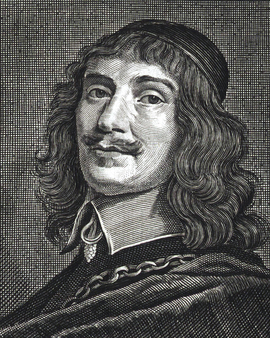Gerrit or Gerard van Honthorst was one of the leading members of the Utrecht School during the Golden Age. Honthorst was first introduced to the basics of painting by his father. The first real training took place in the studio of Abraham Bloemaert, who also taught Hendrik Terbrugghen. After completing his training, Honthorst, like many of his colleagues during this period, went to Italy, where they studied modern and ancient Italian art. In Rome his most important patrons were the banker and art collector Vincenzo Giustiniani and Cardinal Borghese. Giustiniani, in whose palace Honthorst lived, possessed a considerable collection of contemporary Italian art. This included works by Caravaggio, Bartolomeo Manfredi and Carracci. Caravaggio's style in particular strongly influenced Honthorst's later works. Honthorst had a special talent for depicting scenes in artificial light and mastered the associated light-shadow effects to perfection. Often the whole evening scene was illuminated by a single candle, as in "Adoration of the Child". This earned him the nickname Gherardo della Notte (Gherardo of the Night) in Italy.
Around 1620 Honthorst returned to Utrecht. Soon he had a good reputation that even went beyond the borders of the country. He joined the Luke's Guild in 1622 and in the following year he was already appointed its president. In the following years he received numerous commissions from various aristocratic houses. He painted various portraits for Charles I of England, as well as for the Bohemian royal couple living in exile in the Netherlands, and is said to have given painting lessons to their four children. Honthorst was later appointed court painter of the Orange royal house. This brought him so many commissions that he had to open a second studio in The Hague. He had many students and assistants who helped to reproduce his portraits. One of his students, Joachim von Sandrat, who also accompanied him to England for commissions, later claimed that Honthorst always had 24 students at the same time, each of whom paid 100 guilders a year for their lessons. But Honthorst was not only a productive and successful portrait painter who earned very well. He played a leading role in the development of Dutch painting. Together with Terbrugghen, he was a model and leading figure of the Utrecht Caravaggists. Rembrandt is said to have come closer to Caravaggio largely through studying Honthorst's works.
Honthorst was married to his cousin. His younger brother Willem van Honthorst was also a successful portrait and history painter. Since he was taught by Gerrit and his teacher Bloemaert, the style and motifs of the two brothers are very similar. Initially, many of Willem's works were wrongly attributed to the older Gerrit, which was partly due to the similar style but also the similar signatures of the two. The brothers are also said to have worked together in Gerrit's studio for several years. Honthorst's special appreciation for Peter Paul Rubens became clear when he invited him to dinner at his estate in Utrecht. On that occasion he made a portrait of Rubens, portraying him as the "righteous man" described by Diogenes. Honthorst spent the rest of his life in his home town of Utrecht from 1652.
×





.jpg)
.jpg)
.jpg)
.jpg)
.jpg)
.jpg)
.jpg)
.jpg)
.jpg)
.jpg)
.jpg)
.jpg)
.jpg)
.jpg)
.jpg)
.jpg)
.jpg)
.jpg)
_Queen_of_Bohemia_by_Honthorst_-_(MeisterDrucke-995246).jpg)
_Queen_of_Bohemia_by_Honthorst_-_(MeisterDrucke-995246).jpg)
.jpg)
.jpg)
_-_(MeisterDrucke-290795).jpg)
_-_(MeisterDrucke-290795).jpg)
.jpg)
.jpg)
.jpg)
.jpg)
_Fils_de_Frederic_V_du_Palatinat_-_Portrait_of_P_-_(MeisterDrucke-941538).jpg)
_Fils_de_Frederic_V_du_Palatinat_-_Portrait_of_P_-_(MeisterDrucke-941538).jpg)
.jpg)
.jpg)
.jpg)
.jpg)
.jpg)
.jpg)
.jpg)
.jpg)
.jpg)
.jpg)
.jpg)
.jpg)
_-_(MeisterDrucke-1661086).jpg)
_-_(MeisterDrucke-1661086).jpg)
_-_(MeisterDrucke-1661101).jpg)
_-_(MeisterDrucke-1661101).jpg)
.jpg)
.jpg)
.jpg)
.jpg)
.jpg)
.jpg)
.jpg)
.jpg)
.jpg)
.jpg)
_-_(MeisterDrucke-1422181).jpg)
_-_(MeisterDrucke-1422181).jpg)
.jpg)
.jpg)
_(159_-_(MeisterDrucke-984431).jpg)
_(159_-_(MeisterDrucke-984431).jpg)
_in_Armour_-_(MeisterDrucke-45381).jpg)
_in_Armour_-_(MeisterDrucke-45381).jpg)
.jpg)
.jpg)
.jpg)
.jpg)
.jpg)
.jpg)
_Prince_of_Orange_(1584-1647)_-_(MeisterDrucke-277098).jpg)
_Prince_of_Orange_(1584-1647)_-_(MeisterDrucke-277098).jpg)
.jpg)
.jpg)
.jpg)
.jpg)
.jpg)
.jpg)
.jpg)
.jpg)
.jpg)
.jpg)
.jpg)
.jpg)
.jpg)
.jpg)
.jpg)
.jpg)
.jpg)
.jpg)
.jpg)
.jpg)
.jpg)
.jpg)
.jpg)
.jpg)
.jpg)
.jpg)
.jpg)
.jpg)
.jpg)
.jpg)
.jpg)
.jpg)
.jpg)
.jpg)
.jpg)
.jpg)
.jpg)
.jpg)
_-_(MeisterDrucke-1644461).jpg)
_-_(MeisterDrucke-1644461).jpg)
.jpg)
.jpg)
.jpg)
.jpg)
 Duke of Amalfi - (MeisterDrucke-91025).jpg)
 Duke of Amalfi - (MeisterDrucke-91025).jpg)
.jpg)
.jpg)
.jpg)
.jpg)
 Prince of Orange a - (MeisterDrucke-607779).jpg)
 Prince of Orange a - (MeisterDrucke-607779).jpg)
_-_(MeisterDrucke-1655417).jpg)
_-_(MeisterDrucke-1655417).jpg)
.jpg)
.jpg)
.jpg)
.jpg)
_-_(MeisterDrucke-271807).jpg)
_-_(MeisterDrucke-271807).jpg)
.jpg)
.jpg)
.jpg)
.jpg)
.jpg)
.jpg)
.jpg)
.jpg)
.jpg)
.jpg)
.jpg)
.jpg)
.jpg)
.jpg)
_depicted_as_Mars_when_-_(MeisterDrucke-1377039).jpg)
_depicted_as_Mars_when_-_(MeisterDrucke-1377039).jpg)
.jpg)
.jpg)
.jpg)
.jpg)
.jpg)
.jpg)
.jpg)
.jpg)
.jpg)
.jpg)
_-_(MeisterDrucke-906581).jpg)
_-_(MeisterDrucke-906581).jpg)
.jpg)
.jpg)
.jpg)
.jpg)
.jpg)
.jpg)
.jpg)
.jpg)
.jpg)
.jpg)
.jpg)
.jpg)
.jpg)
.jpg)
.jpg)
.jpg)
.jpg)
.jpg)
.jpg)
.jpg)
.jpg)
.jpg)
_nephew_of_King_Charles_I_(1600-49)_-_(MeisterDrucke-555989).jpg)
_nephew_of_King_Charles_I_(1600-49)_-_(MeisterDrucke-555989).jpg)
_-_(MeisterDrucke-1001744).jpg)
_-_(MeisterDrucke-1001744).jpg)
.jpg)
.jpg)
.jpg)
.jpg)
.jpg)
.jpg)
.jpg)
.jpg)
.jpg)
.jpg)
.jpg)
.jpg)
.jpg)
.jpg)






